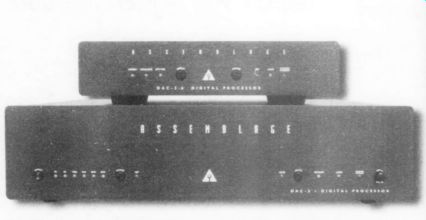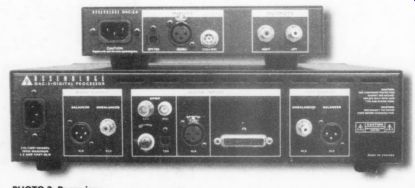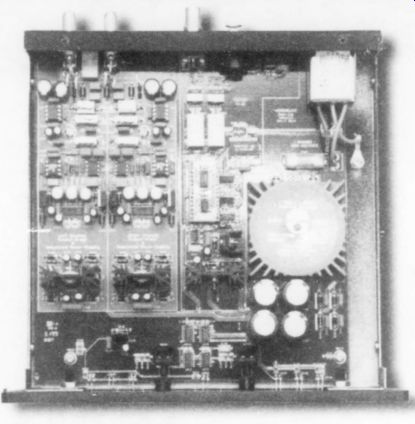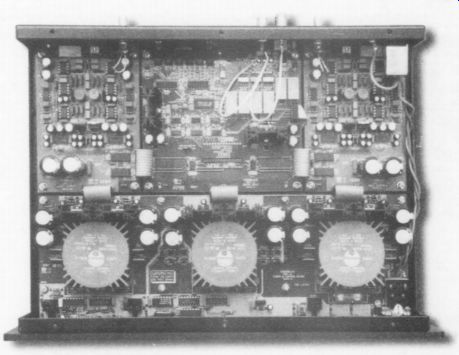Reviewed by YKW.
Assemblage DAC-2.6 and DAC-3.0 digital processor kits.
The Parts Connection, Inc, 2790 Brighton Rd., Oakville, Ontario L6H 5T4, Canada, (800) 769 0747, (905) 829-5858, FAX (905) 829 5388.
Price, DAC 2.6: $699 kit, $799 assembled; DF-1704 digital filter board: $50; parts upgrade kit: $159, $209 installed; turbo mod (four OPA-G27 op amps): $50.
Price, DAC 3.0: $1499 kit, $1599 assembled; DF1704 digital filter board: $50; parts upgrade kit: $299, $399 installed.
The DAC 2.6 and DAC 3.0 are the latest digital-to-analog converter products from The Parts Connection. With the introduction of these DAC kits, The Parts Connection (TPC) has moved into the 96kHz/24-bit world of digital design.
Both DAC kits employ the Crystal/Cirrus Logic CS8414 input receiver. The CS8414 is the latest-generation Crystal input receiver, supporting sampling rates up to 100kHz, as well as all of the standard professional and consumer digital audio interface formats--AES/EB IEC 958, S/PDIF, and EIAJ CP340/1201.
The chip includes an on-board RS422 line receiver, features low-jitter, on-chip clock recovery, and is pin-compatible with Crystal's previous industry standard, the CS8412.
TPC has transformer-coupled the S/PDIF and AES/EBU inputs using Scientific Conversion's superb SC982-04 input transformers. These state-of-the-a digital input transformers are designed for 96kHz sampling rates and feature excellent rejection of common-mode noise, aided by electrostatic shielding between the primary and secondary windings.
Unlike the cheap digital coupling trans formers found in most consumer equipment, the Scientific Conversion trans formers offer extended low-frequency response, which allows the digital clock signal to pass with minimal low-frequency rolloff and phase shift. These are the finest digital audio coupling transformers available.
Like their predecessors, the DAC 2.6 and DAC 3.0 are supplied with Pacific Microsonics PMD-100 HDCD digital filters. This feature will appeal to users who are committed to the HDCD format, but the PMD100 filter does not allow 96kHz/24-bit performance. As an option, TPC offers a plug-in 96kHz/24-bit filter module as a pin-compatible replacement for the PMD100.
This module contains Burr-Brown's DF-1704 24-bit/96kHz, 8x oversampling digital filter. The DF1704 was designed as a companion to Burr-Brown's PCM1704 24-bit/96kHz digital-to-analog converter chip. The PCM1704 is manufactured using a "Bi-CMOS sign-magnitude architecture that eliminates glitches and other non-linearities around bipolar zero," according to the Burr-Brown data sheet. When you fit either DAC with the DF1704 filter module, it offers true 96kHz/24-bit from input to final D/A conversion.

PHOTO 1: Front view of the Assemblage DAC-2.6 and DAC-3.0 digital processors.

PHOTO 2: Rear view.
If you have a DVD transport with a 96kHz/24-bit digital output, you will be able to take full sonic advantage of DVD discs with 96kHz/24-bit PCM stereo audio. Chesky (www.chesky.com) and Classic Records (www.classicrec.com) have issued a number of audio discs with stereo 96kHz/24-bit PCM encoding. These are normally referred to as "DAD" discs and are not to be confused with "DVD Audio" discs, which are not in PCM format. (I have yet to see any DVD Audio software on the market, and only two DVD players support this fledgling format.)
DAC 2.6 PARTICULARS
All of the DAC 2.6 circuitry is housed on a single, four-layer PC board, with careful attention paid to layout and grounding. The DAC 2.6 uses a single PCM1704 DAC chip per channel. The current out put of the 1704 feeds the current-to-voltage (I/V) converter, a Burr-Brown OPAGOA4.
In order to allow DC coupling of the audio path, a servo loop based on a second OPAGO4 op amp is used in the I/V stage. The unity-gain output buffer, which also provides third-order analog filtering, is based on Burr Brown's new OPA134 high-speed op amp. The DAC 2.6 power supply has a single toroidal power transformer and bridge rectifier feeding 11 three terminal IC regulators.
Two Linear Technology LT317/337 pairs provide separate (15V regulation to the analog) circuitry. The +/- 15 regulators also serve as pre-regulators for two 7805/7905 pairs, which provide separate +5V rails to the left and right DAC chips. A single 7812 supplies power to the various LEDs on the front panel and the input selection relays. The 7812 also serves as a pre-regulator to a pair of 7805 regulator chips, which power the input receiver, the digital filter, and the logic chips used for input selection.
The DAC 2.6 has three digital in puts-an AES/EBU input equipped with an XLR connector, a TOSLINK optical receiver, and a PC-mounted 75-ohm BNC connector for S/PDIF. Don't complain about the lack of an RCA connector for the S/PDIF input. If you are still using RCA connectors for S/PDIF, you are not hearing the full potential of digital audio. These DACs deserve the very best-change your cables and the rest of your connectors to true 75-ohm BNC, if you haven't done so already (see my article "Optimizing the S/PDIF" in AE 4/98 for further information). TPC sup plies an RCA-to-BNC adapter for those who stubbornly refuse to change to BNC connectors.
The parts quality in the DAC 2.6 is excellent, but further improvements are made possible by the optional Signature Parts Upgrade Kit.
This kit includes Analog Devices AD811 I/V converter chips, Holco and Caddock resistors, Multi-cap-film capacitors and Sanyo Oscon electrolytic capacitors, Linear Technology LT1033 and 1085 regulators, Kimber RCA input jacks, Kimber AGSS hookup wire, and a square of Sound chassis damping material. A further option is the replacement of the I/V converter and output buffer ICs with Burr-Brown OPAG27AP types. The design of a 24-bit DAC has required rethinking of I/V noise requirements, due to the increased dynamic range made possible by 24-bit audio. The OPAG27AP has the lowest noise floor of any IC tested for this application.
DAC 3.0 TPC has designed the DAC 3.0 as a ne plus ultra product. The 3.0 incorporates many of the same concepts as the 2.6, but with some significant enhancements that result in considerably greater complexity. The 3.0 has six digital inputs: two S/PDIFs ( 75-ohm BNC and RCA), AES/EBU, Toslink Optical, ST Glass Optical, and I2S-e (enhanced I2S). SC-982-04 transformers are used to couple the S/PDIF and AES/EBU inputs. The input receiver and HDCD digital filter are the same, and the same DF-1704 filter module can also be used in the DAC 3.0, which has both balanced XLR and unbalanced RCA analog outputs.
Unlike the DAC 2.6, which houses all parts on a single PC board, the DAC 3.0 incorporates four separate PC boards and has been designed in a modular, upgradable fashion.
The power-supply board houses three toroidal power trans formers. Each transformer feeds a pair of bridge rectifiers (six bridges total), which, in turn, feed six three-terminal IC regulators.
The rectifier diodes are SF4002 (or HFA4002), a soft-recovery, low-noise replacement for the 1N4002. Two LT317/ 337 pairs supply +15V left and right rails for the analog circuitry. Two 7812 regulators supply power to the front-panel LEDs and input selection relays. The 7812s also serve as pre-regulators to four 7805 regulators housed on the digital input board.
The digital input board contains most of input selection circuitry, the input receiver, and the digital filter. The output of the digital filter is buffered by a pair of 74AC86 EX-OR gates, which perform three functions: They allow polarity in version in the digital domain, they provide correct output timing for the 8x oversampled digital datastream, and they supply true differential datastreams for the left and right digital data.

PHOTO 3: DAC-2.6 interior.
The left and right output boards house the D/A converter chips and the analog circuitry. The data from the EX-OR gates is routed to a pair of Burr-Brown ISO-150 dual digital couplers. These couplers are designed as high-performance replacements for traditional opto-couplers but use galvanic isolation capable of data rates of 80MBaud. Unlike opto-couplers, which require high current pulses, the ISO150 Bi-CMOS circuitry requires only 25mW per channel. Each channel of the DAC 3.0 uses a pair of PCM1704 D/A converter chips in a true differential configuration, fed, via the ISO-150 couplers, from the differential output EX-OR gates.
The I/V converter is a Linear Technology LT1357 with an OPAG04 in a servo loop to null the DC offset. The output buffer consists of an OPA134 op amp buffered by a Burr-Brown BUF634 operating in the feedback loop. Separate, identical I/V converter and output buffer circuitry is used for the positive and negative legs, each fed by one of the PCM1704 DACs. This maintains a true differential signal path right to the output XLR connector.
TPC has also very cleverly ensured that the differential DAC and I/V scheme is not wasted for those who use the un balanced RCA outputs. The signal path from each I/V is fed to the inverting input of the OPA134, but it is also fed to the non-inverting input of the opposite leg's OPA134. Each output board contains on-board 7805 and 7905 regulators supplying +5V to the PCM1704 DAC chips. These are pre-regulated by the +15V analog supplies.
A Signature Parts Upgrade Kit is also available for the DAC 3.0. This consists of Holco and Caddock resistors, Os-Con electrolytic capacitors, International Rectifier Hexfred diodes for the 15V power supplies, Ohm-aha digital hookup wire for the S/PDIF connections, Kimber Ultra-Plate RCA connectors for the analog output and one of the S/PDIF inputs, and a 12" x 6" piece of Soundcoat chassis damping material. Finally, the I/V converters and output buffer op amps are replaced with Burr-Brown OPAG27AP op amps.
GROUNDING AND LAYOUT
In designing the DAC 3.0, extremely careful attention has been paid to layout and grounding. The digital input and the left and right output boards are sophisticated four-layer designs with separate ground and voltage planes. The left and right output boards are not identical- they are mirror images of each other.
TPC uses short lengths of Thomas and Betts flat ribbon cable to make the inter connections between the boards.
The connections from the digital input board to the left and right output board are mirror images, with a differential pin layout and low-impedance high-frequency return paths.
Data lines have been separated with ground return lines. This level of de sign sophistication ensures that the digital circuitry will perform to its full potential.
ASSEMBLY
The DAC 2.6 is a simple Kit to build, since the single PC board is factory assembled. The digital input and the left and right output boards on the DAC 3.0 are also factory-assembled.
But, assembly of the power-supply board is left to the builder. There's really quite a bit of assembly on this board, including six ICs and support parts associated with input switching, so it is likely to keep kit builders busy (and happy!) for quite a while.
I got one of the first DAC 3.0 kits and an early version of the assembly manual.
There were quite a number of glitches in the assembly procedure, but these have all been corrected, so there's no need to detail them here. I am always impressed by TPC's responsiveness to feedback, and they were most receptive to my comments on the assembly procedure. The construction quality of the PC boards, chassis, and front panels for both of these DACs is up to TPC's usual standard-in other words, it's first-rate.
THE SOUND
The DAC 2.6 and 3.0 were supplied to me with the Signature Parts Upgrades al ready installed on the PC boards. I have been favorably impressed with the sonic improvements rendered by TPC's parts upgrades in the past, and I decided not to reinvent the wheel. Both units were shipped with the HDCD digital filters in stalled, and I was also sent one of the PCM 1704 96kHz/24bit filter modules.
The Parts Connection also loaned me a sample of their UJB-1 clock jitter suppressor, and TPC's Glenn Dolick encouraged me to compare the performance of these new DACs with and without the UJB-1. The UJB-1 is a revised version of parent company Sonic Frontiers' Ultra Jitter Bug, based on the Ultra Analog AES21 input receiver. I also tried my custom-built AD1890-based unit, a reference-quality jitter suppressor that has improved the sound of every D/A converter I have used it with-until now. To my surprise, both of these jitter suppressors actually degraded the performance of the DAC 2.6 and 3.0. Insert them in the digital path, and the sonic presentation becomes somewhat diffuse, veiled, and less refined.
How can this be? The Crystal CS8414 input receiver has jitter attenuation characteristics comparable to the 8412, so there must be more going on here than meets the eye. Many factors can affect jitter, beyond the characteristics of the chips themselves. TPC has been extremely careful to ensure that grounding and layout do not degrade jitter performance. The DAC 2.6 and 3.0 probably have lower internal jitter than these out board devices, so that inserting them in the digital signal path results in a degradation. The superb performance of these DACs, with out any external jitter suppression, is a testament to a high level of digital design sophistication at The Parts Connection. The UJB-1 has now been discontinued and TPC has just announced their D2D-1 Sample Rate Converter. This new device upsamples all incoming digital data to 96kHz and feeds the upsampled output to the DAC 3.0 via an I2S- cable. With an inherent jitter spec of only 2ps, this may be the only outboard device that can actually improve the performance of these DACs units with the stock HDCD filter, as well.
With the HDCD filter, these products perform beautifully, and those who are heavily committed to HDCD will probably find them a substantial improvement over previous DACs and CD players using this technology. However, the PCM1704 filter provides a far more refined sonic presentation on conventionally recorded CDs. Unless you are an HDCD die-hard with an indispensable collection of these discs, I suggest using the PCM1704 filter.

PHOTO 4: DAC-3.0 interior.
The DAC 2.6 represents a significant improvement over previous DACs from The Parts Connection (see my reviews in TAA 2/95 and AE 5/97).
The 24-bit circuitry al lows a new level of de tail, resolution, and low-level ambience to emerge from your CDs. Soundstaging also takes on a new level of precision.
With the PCM1704 filter module in stalled, the DAC 2.6 easily outperforms the Monarchy Models 22C and 33, which I reviewed in AE 2/99.
The new digital circuitry in the 2.6 simply allows you to get close to the real sound recorded on your discs than the Monarchy units do. As such, the midrange performance of the 2.6 is accurate, rather than euphonically colored, and is as musical as your recordings will allow it to be. The DAC 2.6 has greater inner detail, a lower noise floor, and a more airy, lifelike treble region. Even with the HDCD filter, the DAC 2.6 is a new reference in its price class, still edging out the Monarchy for overall accuracy and transparency.
TWICE AS GOOD?
As impressive as the DAC 2.6 is, the DAC 3.0 raises digital audio to an entirely new level of performance. The 3.0 is over twice as expensive as the 2.6, and potential purchasers will surely need to know if it's really over twice as good. In audio, like many other areas, we often reach a point where performance is so good at a given price level that it takes considerable additional expense to yield even small improvements. This is not the case with the 2.6 versus the 3.0. These things are admittedly difficult to quantify, since listening evaluations are necessarily subjective. But, in my opinion, the DAC 3.0 is easily "twice as good" as the 2.6, and probably even better than that! The DAC 3.0 has an uncanny sense of detail and articulation. I was particularly impressed with the pizzicato strings at the beginning of Ernest Ansermet's superb performance of Ravel's Alborada del Gracioso (Decca/London 433 717-2).
The sound of the strings is surrounded with a natural warmth and hall ambience that I have never before heard on this CD.
The 3.0 is really pristine in its sonic presentation. My best CDs are incredibly clean and transparent, as if the final layer of veiling has been lifted. Dynamics are unbridled. More than any other DAC I have heard, the 3.0 is able to maintain its clarity, transparency, and sonically clean qualities in the loudest and most densely scored passages.
Soundstaging is a hallmark of the 3.0.
Antal Dorati's Mercury recording of Schoenberg's Five Pieces for Orchestra (432 006-2) continues to be one of my soundstage references. The scoring of these pieces is a real showcase for image and depth, and the 3.0 has revealed subtleties in localization that I have not heard before. Decca is now remastering many classic opera recordings conducted by Georg Solti, and produced by John Culshaw, with 96kHz/24-bit technology, converted to the CD standard in the digital domain.
In Strauss' Salome, with Birgit Nilsson in the title role (414 414-2), the large soundstage captured by Culshaw and his engineering team is rendered with superb precision, with the subtle movements of the singers more faithfully captured than before. The warmth and rich ness of the ambience of Vienna's Sofiensaal around the Vienna Philharmonic's low brass and low strings is palpably real, with the low brass deep in the soundstage. Similarly, the warm, vibrant texture of the low strings is also stunningly revealed at the beginning of "Siegfried's Funeral March" in the Solti / Decca Wagner Ring (455 555-2; not a 96kHz/24-bit remastering).
But the DAC 3.0 is in no way analytical. The superior clarity is invariably ac companied by greater warmth and ambience. Each section of the orchestra emerges with greater detail, yet is enveloped by the space of the recording venue. In other words, the recorded orchestra sounds closer to the real thing.
The high frequencies are smooth and silky with the 3.0. The soft, high strings in Antal Dorati's Mercury CD of Respighi's The Birds, a difficult recording on less than optimum equipment (432 007-2), have a natural sweetness of texture and a realistic harmonic extension and airiness. The bass region is hefty, but extremely well controlled. The weight and transient impact of the low percussion on Lorin Maazel's idiosyncratic reading of Stravinsky's Le Sacre du Printimps, on the second Telarc CD edition (CD 82001), are excellent. You can clearly delineate the bass drums and various tympani, both in terms of timbre and location.
I recently purchased EMI's bargain box CD reissue of the complete Mahler Symphonies featuring the London Philharmonic Orchestra conducted by Klaus Tennstedt (CDZK 72941). Over half of these recordings were early EMI digital efforts, and the remaining analog recordings were transferred to digital back in 1984. The digital recordings can sound quite aggressive even on their LP incarnations.
These, and other difficult digital recordings (Deutsche Grammophon), are more pleasant and musical than be fore. Though they will never compete sonically with the best recordings in my collection, I am now at least able to hear the music through the recording technology--the DAC 3.0 simply provides a more pleasant listening experience with these discs. These now-primitive digital recordings still sound bright in tonal balance, but the DAC 3.0 minimizes the harshness.
Both the DAC 2.6 and 3.0 are utterly neutral in tonal balance. If your CD sounds bright, you can be sure that what you are hearing is on the disc itself. The DAC 2.6 offers a real taste of all of the performance characteristics mentioned above. But, the DAC 3.0 takes them all to a new level of refinement. The one you decide to purchase will simply depend on your budget.
Aside from its stellar performance, one of the nicest things about the DAC 3.0 is the possibility of upgrades. The modular construction allows boards to be re placed individually as improvements are made. TPC has informed me that a new digital input board, which will incorporate a second phase-locked loop to further reduce jitter, is under development.
It will also have a new PMD200 digital filter from Pacific Microsonics. This filter will provide true 96kHz/24-bit performance, in addition to properly decoding HDCD discs, so you won't need to choose between them.
DVD AUDITION
As I was completing this review, I purchased my first DVD player, a Pioneer DV-525. This is one of the only players I have seen with a 96kHz/24-bit S/PDIF output. I also purchased Classic Records 96kHz/24-bit DAD release of the Ravel Orchestral Works with the Minnesota Orchestra conducted by Stanislaw Skrowaczewski (DAD 1025), avail able from Acoustic Sounds (acousticsounds.com). These were originally recorded in 1974 for Vox/Turn about by Marc Aubort and Johanna Nickrenz on a four-track Scully recorder, using 12" tape and Dolby-A noise reduction.
Hearing true 96kHz/24-bit performance in my listening room through the DAC 2.6 and 3.0 has been quite a revelation. I really get the feeling that I have a clean window on these superb original analog tapes. Have we now arrived at the point where even the most die hard LP collectors can embrace digital audio? This is a taste of the exciting future of digital audio, and The Parts Connection has clearly placed itself at the forefront with these excellent products. I could not give a more enthusiastic recommendation.
Also see: